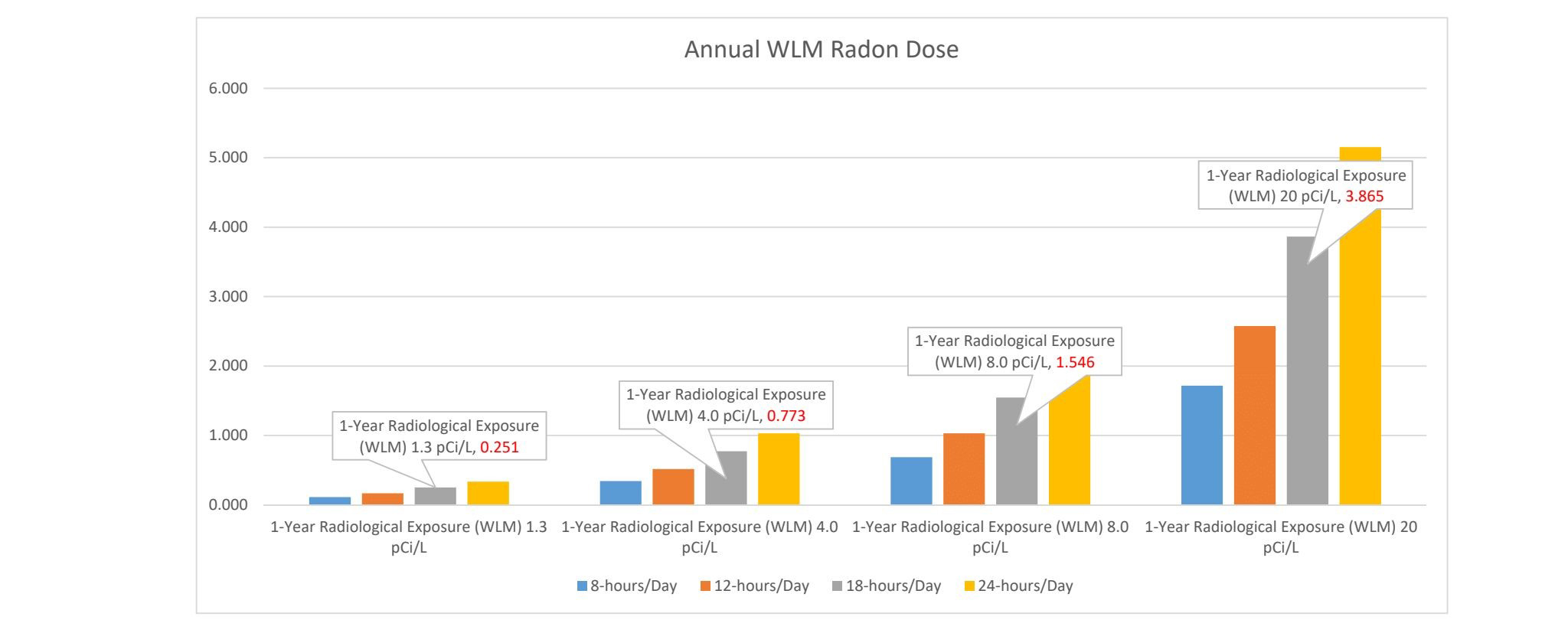Bruce Snead and Brian Hanson – National Radon Program Services at Kansas State University. Special thanks to Kevin Stewart of the American Lung Association for his input.
The leading cause of lung cancer death in people who have never smoked is the person’s radon dose. The primary place people get radon exposure is in their homes. The process by which long-term lung cancer risk from radon exposure is calculated is often not understood by the radon industry or the public. Below, we look at the potential increase in radon dose from radon levels in a home due to increased time at home during the Covid-19 Pandemic.
The risk of cancer from a radiation source like radon is called ‘the dose,’ which is equal to the radiation level of the radon source multiplied by the time of exposure.
Radon Dose = Radon Level x Time of Exposure
In Kansas, approximately 38% of all radon measurements reported are at or above the EPA Radon Action Level of 4.0 pCi/L. The average radon level for all reported Kansas measurements is 4.6 pCi/L. Approximately 2% of Kansas homes have radon levels above 20 pCi/L.1 Under normal circumstances, many people would spend 8-12 hours/day outside the home working, attending school, running a household, and other errands, etc. However, during the pandemic, many have spent those same hours at home for the past several months.
Consequently, we can estimate how much one’s radon dose has changed based on radon levels in the home and the likely increase in the hours at home. Another factor in the radon dose change is the radon levels in the locations now being avoided due to Covid 19. It is possible those levels could be higher than at home, but there is a greater probability of them being lower. EPA lung cancer risk estimate tables are based on 18-hour per day average annual exposure at home and use 1.3, 4.0, 8.0, and 20.0 pCi/L as common radon levels in homes.
The primary radon exposure comes from the proportion of the two polonium particles produced in the air during the ongoing radioactive decay of the radon gas in the home. The unit of measurement for these decay products is the Working Level (WL), which is the amount of polonium available in the environment to be inhaled. 100 pCi/L of radon will produce one working level of the decay products. How much of those decay products are airborne and breathable is determined by the Equilibrium Ratio (ER). To calculate the WL from a known radon concentration, the Equilibrium Ration (ER) of the building must be known or assumed; in general, an ER = 0.5 is assumed for most residences. An ER = 0.5 indicates that approximately 50% of generated polonium is airborne and available to be inhaled by occupants, so that a radon level of 200 pCi/L results in 1 WL of the decay products. This relationship is shown in the formula.
WL = (ER x Radon Concentration (pCi/L)/ 100
Long-term lung cancer risk from residential radon exposure then is equal to the WL of the residence multiplied by the time of exposure. This calculation is known as the Working Level Month (WLM). The number of hours in a working month is 170 (based on 8 hours a day for 21 working days per month). Lung cancer risk over time is calculated based on an individual’s cumulative WLM value.
WLM = (WL x Hours of Exposure)/ 170 working hours in a month
Table 1 presents the radon dose for various radon levels for various hours spent at home assuming an ER = 0.5 meaning half the radon-released particles are in the air available to breathe. The calculations are based on radon exposure in working level months (WLM) for four common indoor radon concentrations: 1.3 pCi/L (the EPA’s estimated national indoor radon average), 4.0 pCi/L (the EPA’s Radon Action Level), 8.0 pCi/L and 4) 20 pCi/L. The dose is calculated at four average daily exposure hours: 8, 12, 18 and 24 hours at home/day.
If time at home for an entire year increases from an average of 12-hours/day to 18-hours/day, the annual radon dose in WLM from the radon levels in the home increases by 50%!
For every additional 1-hour per day spent at home at the same radon level, the annual radon dose increases by about an average of 7%.
Table 1. Annual radon dose when spending 8-, 12-, 18-, or 24-hours in a home with 1.3, 4.0, 8.0, or 20.0 pCi/L radon levels. ER = 0.5
| Time at home | 1.3 pCi/L | 4.0 pCi/L | 8.0 pCi/L | 20 pCi/L |
| 8-hours/day | 0.112 WLM | 0.344 WLM | 0.687 WLM | 1.178 WLM |
| 12-hours/day | 0.167 WLM | 0.515 WLM | 1.031 WLM | 2.576 WLM |
| 18-hours/day | 0.251 WLM (12 hrs +50%) |
0.773 WLM (12 hrs +50%) |
1.546 WLM (12 hrs +50%) |
3.865 WLM (12 hrs +50%) |
| 24-hours/day | 0.335 WLM | 1.031 WLM | 2.061 WLM | 5.153 WLM |
Chart 1. Annual WLM radiological dosage at four common radon concentrations and four average residential time exposure periods.

The local, state, and national level response to the current pandemic conditions has radically changed how many families spend their time. It is the responsibility of the radon industry in (public and private sectors alike) to help clients understand how shifting use in residential spaces can impact their long-term lung cancer risks from radon exposure. Although, as a general approximation, a 50% increase in annual dose over a year might result in a 1-3% increase in lifetime lung cancer risk due to radon, bear in mind that the additional risk will continue to increase should that higher dose become persistent over many years.
As always, when your clients ask questions to which you may not know the complete answer, please feel free to refer them to the National Radon Program Services (NRPS) and our hotline (800.767.7236) or www.sosradon.org.
- KS Dept of Health and Environment; https://kansasradonprogram.org/county-map

